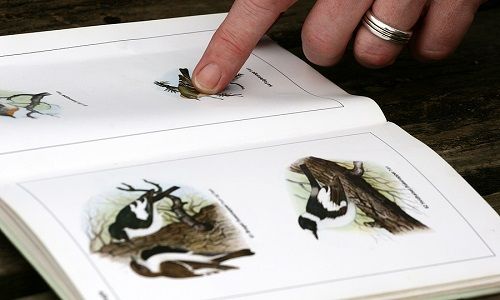Tips for Printing Outdoor Field Guides and Field Manuals

estimated reading time: 4 minutes
Field Guides and Field Manuals
are reference books designed for outdoor use. Because these books share some
similarities, it is common for the terms "field guide" and "field manual" to be
used interchangeably. However, though both are used out of doors, field guides
and field manuals are usually meant for different purposes.

Field Guides
Field Guides are commonly used to help identify animals and plants,
as well as rocks, seashells, and other objects found in nature. As such, field
guides contain photos and/or detailed illustrations, as well as thorough
descriptions and habitat information for the subjects on which they focus.
Field guide topics are as varied as nature itself, and include
birds, mammals, reptiles, insects, wildflowers, trees, mushrooms, rocks,
seashells, fossils, constellations, and other things found in the natural
world.
Field guides can be general in scope, or they can focus on a
specific group of organisms or objects. They can also cover a wide geographical
area or be limited to a particular locale or region. Whichever approach is
used, field guides provide a great resource for learning about nature, whether performing
scientific research or simply having fun exploring the living world.
Field Manuals
Whereas field guides provide
users with information about various creatures, plants, or objects, a Field
Manual is a book of instructions or procedures intended to help users accomplish
various tasks while in the great outdoors.
For example, a field manual might
address topics related to surviving in the wilderness, such as foraging for edible plants, trapping wild animals, or making a shelter. Field manuals
can also focus on various recreational activities such as camping, fishing, or hunting, thereby providing instructions for cooking over a fire, tying knots, dressing
wild game, etc.
Since the outdoors can be unpredictable, or even perilous, other popular topics for field manuals include terrain navigation, dealing with
extreme temperatures, first aid, and emergency preparedness.

Tips for Printing Books to be used Outdoors
Whether you are planning to print field guides or field
manuals, here are some important things to consider when creating books for
outdoor use:
Size - Since the
books will be used in an outdoor environment, they are likely to be carried in
a backpack, gear bag, or pocket. As such, it is important to choose a size that
is convenient to transport - such as 3.5" x 5", 4" x 6", 5" x 7", or 5.5" x 8.5".
Even though the overall dimensions of the book should be on the smaller side,
the font used for the text copy should remain at a size that is easy to read.
Durability - To
help the book stand up to rough handling or rugged terrain, consider using a thicker
paper stock for the cover and pages. Also, rounding the corners of the book can
help it slide into a pocket or backpack without snagging. This prevents the cover
and pages from becoming bent and dog-eared, thus maintaining the book's appearance
and prolonging its lifespan.
Weather Resistance -
Because outdoor books might come in contact with dirt and/or moisture, it is recommended
that the cover and pages have some type of protective coating applied, such as
a UV coating or a clear laminate film. However, a protective coating is not
recommended for pages that will need to be written upon, such as pages designated
for field notes. Though it costs a little more, synthetic paper is an ideal substrate
for field guides and field manuals. Synthetic paper is a plastic-like material that
not only resists grime and moisture, it can be written upon with pen or pencil.
Clarity - Nature
is largely unpredictable, so one never knows what the weather or lighting conditions
will be like when a field guide or manual needs to be referenced by the user. Hence, the content within the book should have good contrast and readability. All photos and illustrations should be clear and sharp. Also, the headings, subheadings, and text should be concise and easy to understand. By the way,
if a protective UV coating or laminate is used, consider a matte finish to
minimize glare from sunlight.
Binding Style - Choose
a binding style that is hard-wearing and user friendly. Perfect binding with PUR
glue is a very strong and flexible option for binding softcover books.
Hardcover binding is durable, but its bulk and rigidity can affect its
portability. Spiral coil binding is very resilient and the most user-friendly
binding option. The plastic binding coils are not only waterproof, they allow the
cover and pages to open a full 360 degrees for easy referencing. By the way, if you are looking to create the ultimate outdoor book, synthetic paper bound with a plastic coil provides the ideal solution. The book will be completely waterproof, dirt/mud resistant, and very easy to use in the field.

Field guides and field manuals provide quick and accurate information for nature lovers and outdoor enthusiasts. They are also very reliable. Unlike digital devices like smartphones, tablets, or laptops, printed books do not rely on batteries or a broadcast signal to function.
Ready to Print your Field Guide or Field Manual? Color Vision is here to Help!
Field Guides and Field Manuals are valuable resources for interacting
with the natural world. So when your books are ready to go to print, just give us a
call at 800-543-6299 and we'll be happy to help.
Or, use our simple Quote Request form to forward
your specifications to us and we will send you a quote by email.
Color Vision has been printing all types of books and booklets for decades, so if you are looking for affordable printing and binding services don't hesitate to get in touch.
As always, we look forward to assisting you!
Related Articles

Creating a Comic Book? Here’s some Advice from a Printer
Read This Article

Perfect Binding vs PUR Binding: What is the Difference?
Read This Article

Perfect Bound Book Printing: Tips for getting the Best Value
Read This Article

How Much Does It Cost to Have Books Printed?
Read This Article